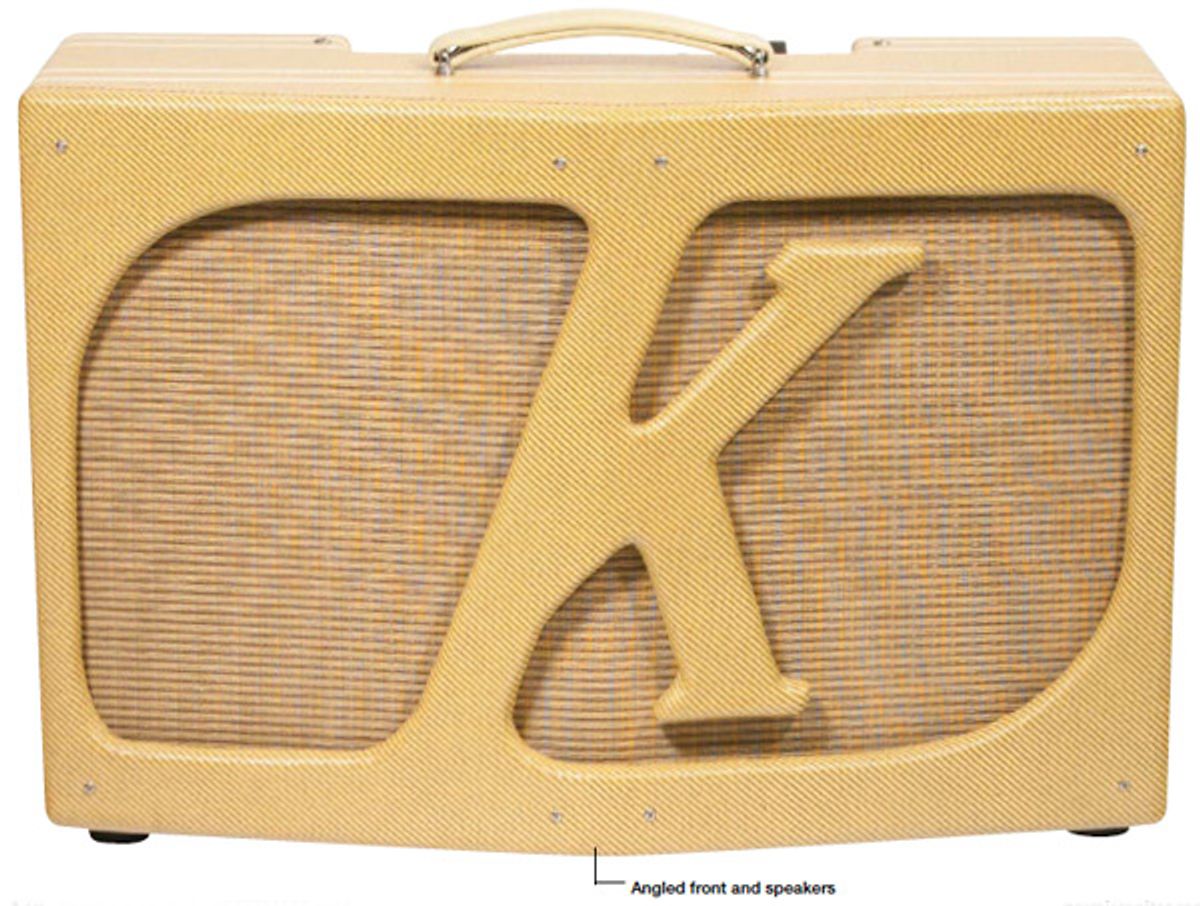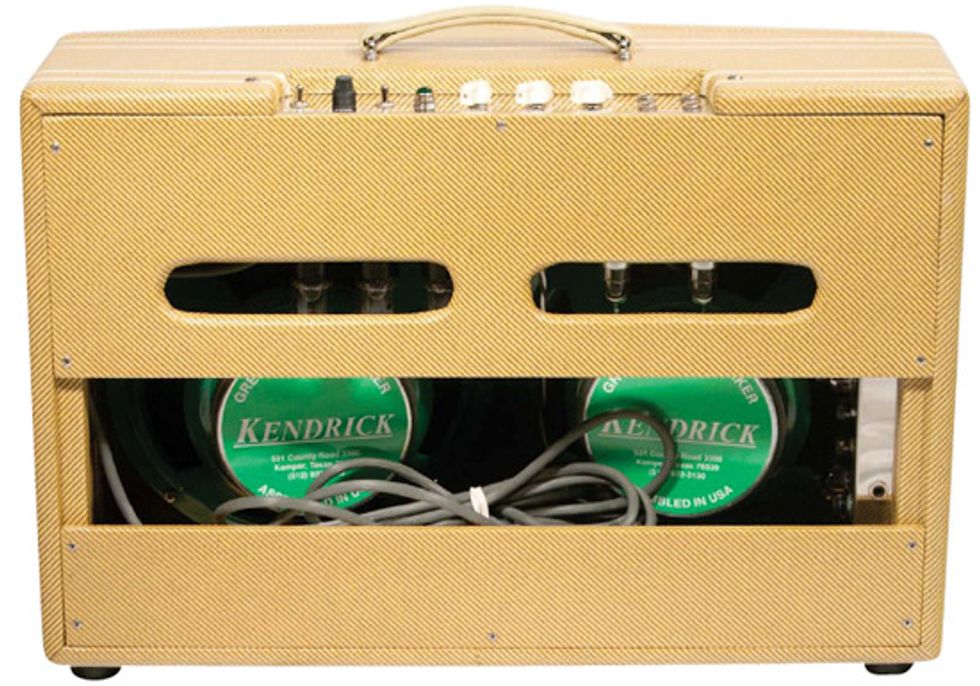
The latest addition to the Kendrick amp line is the V-Front series, and it bristles with Tweed-style tones, Kendrick’s renowned 3-knob reverb, and a speaker array designed to disperse signal more effectively.
Kendrick’s Gerald Weber has been building amps since before boutique amps were big business. Further, since 1989 he’s also been building guitars, writing books (including 1996’s A Desktop Reference of Hip Vintage Guitar Amps), and tweaking the gear of the elite. He also offers amp kits and seminars where students build their own tube amplifiers at his shop in Kempner, Texas. To say Weber is a gearhead’s gearhead would be an understatement.
But just because Kendrick is a walking encyclopedia of vintage amplifier knowledge, doesn’t mean he’s stopped seeking better ways to make guitars loud. The latest addition to the Kendrick amp line is the V-Front series. And in either 2x10 or the 2x12 configuration reviewed here, it bristles with Tweed-style tones, Kendrick’s renowned 3-knob reverb, and a speaker array designed to disperse signal more effectively.
Angled Action
It’s hard not to be struck by the beauty and personality of the V-Front’s cabinetry when you first behold it. The V design is a nod to the ’40s and ’50s, when various manufacturers embraced split-front cabs and angled speakers to improve sound dispersion. Kendrick’s V-Front employs the principle to achieve 340-degree sound dispersion via two Kendrick Greenframe 12" speakers. The cabinet is built of 150-year-old pine covered in Nico-Tweed and adorned with a pair of white racing stripes and a large K built right into the wood of the cabinet. The V-Front feels solid as a rock, and with a triple chrome-plated steel chassis and heavy-duty 20' power cord, it’s clear this amp was built to last a lifetime and then some.
The V-Front uses a pair of 6V6s, four 12AX7s, and a GZ34 rectifier tube to drive its 25 watts. The circuit is built on an epoxy-glass component board that is completely handwired with quality components, including carbon- comp resistors, custom Kendrick electrolytic caps, and a custom paper-bobbin output transformer. The front panel couldn’t be much simpler—four Fender Deluxe-style inputs, three knobs—Volume, Bass, and Treble—a green power indicator, and on/off and standby switches. Inside the cabinet you’ll find the reverb’s Dwell, Tone, and Mix knobs—just like the ones on an old Fender Reverb unit. It’s not an ideal placement if you intend to switch settings on the fly, though I rarely changed settings over the course of the test period.

Clean to Rockin’
I rounded up four guitars to play through the V-Front—a 2003 Les Paul, an American Standard Strat, a Hamer Korina Special with P-90s, and a Richmond Dorchester with Lace Alumitones. Given the amp’s minimal control set, I hoped the simpler circuitry would show off each guitar’s personalities, and a few quick switches between guitars proved me right.
Jumping off from Leo Fender’s Tweed designs, the V-Front uses four inputs of varying resistance. Running the Stratocaster into the higher-output No. 1 input, with Treble and Bass set at noon, the Kendrick was gloriously clean and brimming with harmonic complexity. It didn’t stay clean for too long, though. Because the V-Front uses just two 6V6s, there isn’t a ton of headroom, and by the time the Volume reached noon the breakup was quite apparent. Make no mistake, though, this was far from a disappointment! The complexity in tone, dynamics, and interplay between the guitar and amp were addictive at higher volumes—and the breakup was nothing short of delicious.
The No. 2 input displayed a bit more top end and a slightly clearer tone overall, while No. 3 exhibited a more saturated sound and No. 4 had a bit more saturation. All four proved useful for getting the tone just right in a given situation, and it’s a simple but super-effective way to extend the amps range and functionality.
With the Dorchester in a variety of open tunings and the Kendrick’s reverb set up for a nice, ethereal wash, the tone became meatier—sort of a mix between George Thorogood’s “Bad to the Bone” and Zep’s “Travelling Riverside Blues.” The bottom end is smoking and authoritative, and the top end is glassy without any harsh overtones. Pushing the volume further still puts the Kendrick in raunchier territory, though it retains the definition that a smaller amp sometimes loses amid that much drive. The brilliant reverb circuit is never intrusive, though it can be dialed up to be very present.
The Hamer Korina proved to be one of the best, most rocking pairings for the V-Front. Power chords sounded positively filthy, raunchy, aggressive, and thick with harmonics. Single notes above the 12th fret screamed and teetered on the verge of beautiful harmonic feedback. The brash and bratty potential of the V-Front with P-90s alone makes this an amp well worth consideration.

The high output Les Paul produced the results you might expect—more gain, more harmonic content, and more rock ’n’ roll. There’s something very natural about the pairing of the humbuckers and the Kendrick. The inputs offered a wealth of sound options: No. 2 gave me a little more clarity, while 3 and 4 had a little more push. Because the Les Paul tended to compress more, the tones were more mid-centric but still very bold and clear. Montrose and Zeppelin tones were easy to access, and it was a pleasure to pull the reverb back and hear the resonance of the 150-year old pine cabinet, and the focus, big bottom, and screaming highs of the Greenframe speakers.
The Verdict
It’s clear that Weber’s decades of experience have paid big dividends in the beautifully designed V-Front. From its custom transformers, caps, and speakers, to its pine cabinetry and a reverb circuit that ranks among the best spring reverbs I’ve heard, this amp is a winner. The simple circuitry and use of individually voiced inputs is a perfect way to fine-tune the amp for use with any guitar. More importantly, the V-Front is a fun amp to play. It doesn’t have a ton of clean headroom, but it’s remarkably responsive to picking dynamics and control, and it encourages you to dig in for additional aggression. Volume-wise, it’s pretty much the perfect blend of loud bedroom amp and soundman-friendly club tone. You could rehearse with a full band and probably not worry too much about being heard, thanks to the cabinet design, and that’s a beautiful thing. Kendrick has indeed found the sweet spot with the V-Front.
Buy if...
you need impeccable retro tweed tones with killer reverb.
Skip if...
you need more headroom for clean sounds, and/or modern appointments such as channel switching and effects loops.
Rating...
Street $2995 - Kendrick Amplifiers - kendrick-amplifiers.com |
